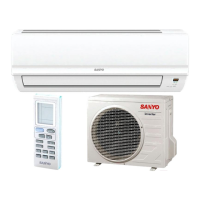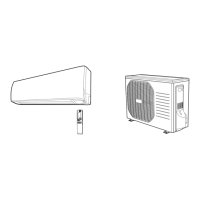Min. 8 mm
min. 8 mm
Fig. 32
4-2-4. Connecting Tubing between Indoor and
Outdoor Units
•Tightly connect the indoor side refrigerant tubing
extended from the wall with the outdoor side tubing.
(Fig. 30)
•To fasten the flare nuts, apply specified torque as:
4-2-5. Insulation of Refrigerant Tubing
To p reve n t he at lo ss a nd we t f lo or s d ue t o dr ip pi ng o f
condensation, both tubes must be well insulated with
a proper insulation material. The thickness of the insu-
lation should be a min. 8 mm. (Figs. 31 and 32)
4-2-6. Taping the Tubes
•At this time, the 2 refrigerant tubes (and electrical wire
if codes permit) should be taped together with armor-
ing tape. The drain hose may also be taped together
as 1 bundle with the tubing.
•Wrap the armoring tape from the bottom of the
outdoor portion to the top of tubing where it enters the
wall. As you wrap the tubing, overlap half of each pre-
vious tape turn. (Fig. 33)
•Clamp the tubing bundle to the wall, using 1 clamp
approx. every 120 cm.
Do not wind the armoring tape too tightly, since this will
decrease the heat insulation effect. Also, be sure the
condensation drain hose splits away from the bundle and
drips clear of the unit and the tubing.
4-2-7. Finish the Installation
After finishing insulating and taping over the tubing, use
sealing putty to seal off the hole in the wall to prevent
rain and draft from entering. Fig. 34 shows refrigerant
tubing taped separately from the drain hose.

